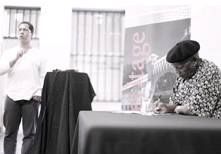
Arriving at Constitution Hill last Thursday evening, I found myself empathising with whoever is charged with taking care of the place. Mirror neuron, the effect is called.
The place looks derelict; soulless; ghoulish. It resembles a destination where one got sent for being a menace to society, for failing to obey the order of the day.
And as I discovered soon afterwards, Constitution Hill used to be a prison and even South Africa’s most famous prisoner, Madiba did a brief stint in there. Obviously. Fitting, then, to choose it as a location for an exhibition entitled: The Forgotten People – Banishment under Apartheid, based on a book by Dr Saleem Badat, Rhodes University’s Vice Chancellor.
Approaching the entrance at the Old Fort Mess Hall, I catch a glimpse of an old timer seated on a chair, taking a register of the attendants. After exchanging greetings and filling in my details (name, e-mail, phone number), I offer to swap shirts when the opening ceremony is done. He was dressed in one of those iconic Madiba shirts, yellowish and black in colour, with a black beret on his chiskop’d head. ‘Proper jazz cat’, I thought to myself. “Only if you give me your woman,” was his reply to my proposition.
Inside the venue, a lady asked me who the gentleman in the black beret is. I did not know, so I asked someone else.
“Professor Ntuli,” they said. “Ah, I’ve seen him on TV. He’s a poet.” Said the lady who had asked initially. I excused myself.
Professor Ntuli was one of the speakers, along with Wits University’s Dr Noor Nietagodien at the Forgotten Peopleexhibition. I found his perspective on the idea of banishment as it relates to modern day South Africa illuminating, hence my decision to pull him aside for a brief chat during his downtime. This is how it went down.
Mahala: The balance of the economy still plays a huge role in the politics of space. What about the outskirts, don’t people from those little towns also have a role to play in our economy?
Professor Ntuli: I think all these forms of power constructions, constricting people, they undergo change, they’ve become more sophisticated. Banishment was very brutal, where they literally lifted you up and took you away. But today they don’t have to, they’ve got to move the locus of economic power to centres, and then you control those centres.
It started, for instance, in the townships. Do you know that until after independence, when you entered into any township, there was only one gate you were going in and one gate you were going out? It was constructed as a military complex. So as to be easily controlled. They were, in a sense, banishment areas. You wouldn’t walk in town by night. After 9 o’clock, if you were a black person, you were not allowed to.
The way you look at it today, the rising poverty, the gap between the rich and the poor is actually increasing, and the poor are being the ones actually isolated – banished from getting their slice of the national cake. People living in those informal settlements, they are dragged away from the rural areas. And those rural areas are actually being sold out.
I found it strange that, in a place like the Maboneng precinct, coming from the Kensington side into it, and then exiting towards inner-city Joburg, one feels as though you’ve been transported into a whole different world. A world devoid of the poverty surrounding it…
Not just poverty, desperate poverty!
Right. What does that say to us as a society? Do we have a natural inclination to be elitist and exclusionary because of our upper-class standing?
When the colonialists and the missionaries came here, they attacked us as a nation. That’s why we fought national liberation wars. Apartheid brought in the colour question. The current regime and all of us here brought in the class question, which is more insidious because the class question in itself separates even the members of the same family according to that. The extended family actually disappears, and people are being banished into the suburbs of poverty.
You have an exhibition coming up next month. What are the works about? What do they centre on?
Some of them centre around the Marikana massacre. Remember the miner in a green blanket? (takes out phone to show me his sculpture of the minuer). This is made from the gearbox of a car. They’re like this; others are in stone, others in wood, they’re made out of wheelbarrow frames… a lot of found objects.
Do you feel that there was enough outcry about Marikana from civil society?
I think people are very angry, they’re still angry. It’s like this, your president says: ‘uyambambezela, leth’u mshini wam’. And then he builds a bunker. And then he militarises the police into generals, brigadiers… this is a language not of civil society. A civil war has been declared, but you’re not even aware!
Story and Images by: Ts’eliso Monaheng.
Source: http://www.mahala.co.za/culture/the-forgotten-people/
